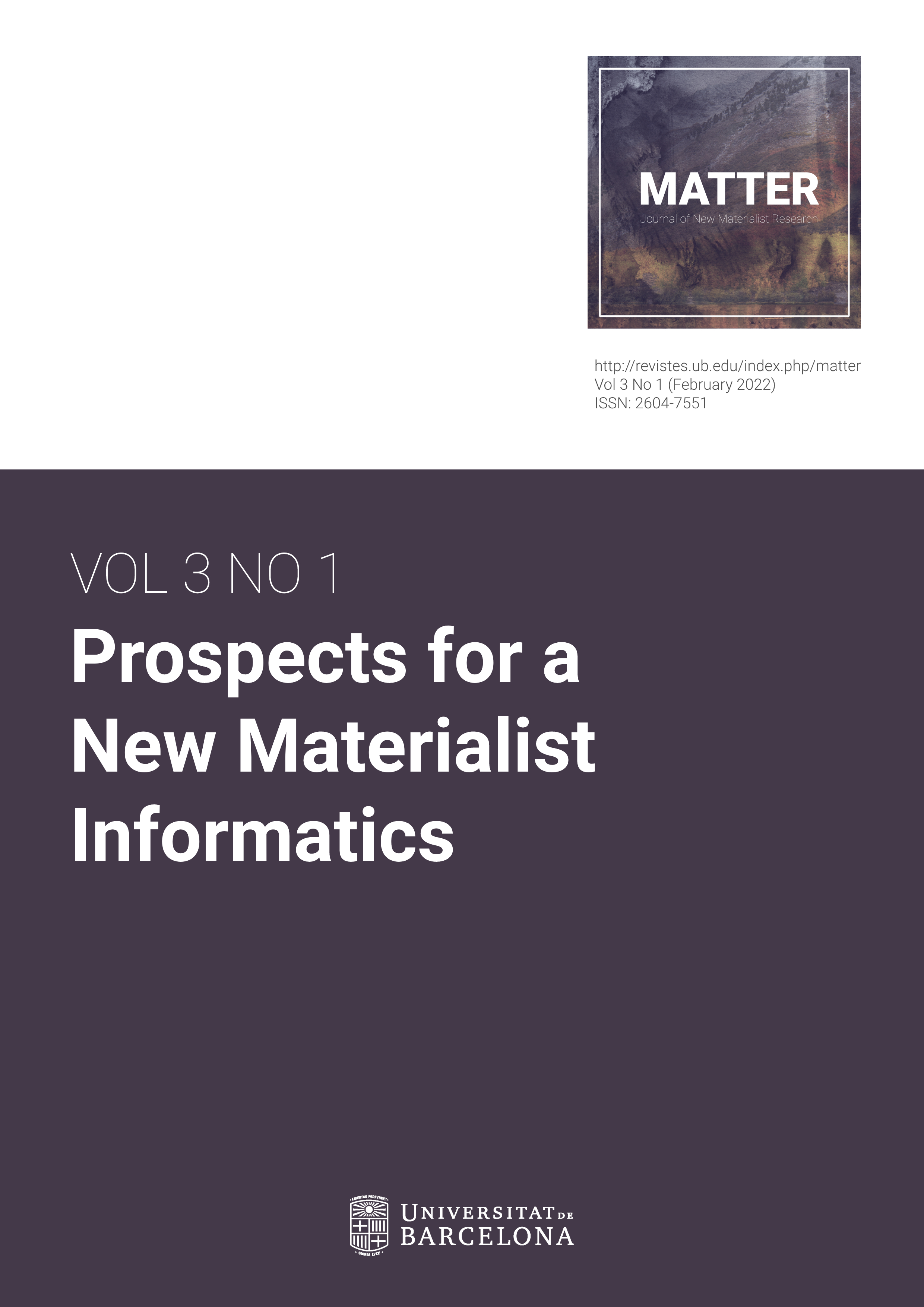Discerning Relational Data in Breath Patterns. Gilbert Simondon’s Philosophy in the Context of Sequence Transduction
DOI:
https://doi.org/10.1344/jnmr.v3i1.38961Palabras clave:
Intensity; Breath patterns; Sequence transduction; Digital wearable stethoscope; Transindividual, Gilbert SimondonResumen
This article discusses Gilbert Simondon’s philosophies of the technical object, information, and individuation to frame the potential inherent in a practical application of his notions of intensity, amplification, and transduction of relational processes, which have been largely neglected in the traditions of substantialist and hylomorphic thought. Specifically, the study introduces a method to discern relational information by amplifying audible breath patterns of a collective via a wearable digital stethoscope (WDS). The non-lexical modality of the breath grants insights into non-verbal phases of communication during which multiple points of view may exist simultaneously. These points of view can be understood as a subject’s sense of orientation within phases prior to signification, i.e., before affect becomes a specific emotion and before perception becomes a concrete action—using the terms as they are defined by Simondon. Bodily movement is audible within the breath and can be further transcribed into preliminary signs with the help of a sequence transduction machine learning (ML) model. Discerning semiosis within audible breath patterns exemplifies a logic of computation which is not concerned with quantitative and qualitative information but, instead, computes intense data to grasp relational dynamics.
Descargas
Citas
Bardin, Andrea. 2021. ‘Simondon Contra New Materialism: Political Anthropology Reloaded.’ Theory, Culture & Society 38(5):25–44. doi: 10.1177/02632764211012047.
Barrett, Lisa Feldman. 2017. ‘The Theory of Constructed Emotion: An Active Inference Account of Interoception and Categorization.’ Social Cognitive and Affective Neuroscience 12(1):1–23. doi: 10.1093/scan/nsw154.
Barsalou, Lawrence. 2003. ‘Situated Simulation in the Human Conceptual System.’ Language and Cognitive Processes 18(5–6):513–62. doi: 10.1080/01690960344000026.
Bateson, Gregory. 1977. Steps to an Ecology of Mind. New York: Ballantine Books.
Bennett, Jane. 2010. Vibrant Matter: A Political Ecology of Things. Durham: Duke University Press Books.
Combes, Muriel. 2013. Gilbert Simondon and the Philosophy of the Transindividual. Cambridge, MA: The MIT Press.
Corness, Gregory James. 2013. ‘Breath as an Embodied Connection for Performer-System Collaborative Improvisation.’ Thesis, Communication, Art & Technology: School of Interactive Arts and Technology.
Crary, Jonathan, and Sanford Kwinter, eds. 1992. Incorporations. New York, NY: Zone Books.
Deleuze, Gilles. 2001. Difference and Repetition. New York: Columbia University Press.
Fazi, M. Beatrice. 2019. ‘Digital Aesthetics: The Discrete and the Continuous.’ Theory, Culture & Society 36(1):3–26. doi: 10.1177/0263276418770243.
Filion-Donato, Émilie. 2021. ‘Psychodynamism of Individuation and New Materialism: Possible Encounters’. Materialism and Politics. Berlin: ICI Berlin Press. 29:233–52. doi: 10.37050/ci-20_13.
Foster, Susan Leigh. 2019. Valuing Dance: Commodities and Gifts in Motion. New York: Oxford University Press.
Grosz, Elizabeth. 2017. The Incorporeal: Ontology, Ethics, and the Limits of Materialism. Columbia University Press.
Irigaray, Luce. 1996. I Love to You: Sketch of A Possible Felicity in History. New York: Routledge.
Manning, Erin. 2007. Politics of Touch. Minneapolis: University of Minnesota Press.
———. 2009. Relationscapes: Movement, Art, Philosophy. Cambridge, MA: The MIT Press.
Massumi, Brian. 1995. ‘The Autonomy of Affect’. Cultural Critique (31):83–109. doi: 10.2307/1354446.
Purwins, Hendrik, Bo Li, Tuomas Virtanen, Jan Schlüter, Shuo-yiin Chang, and Tara Sainath. 2019. ‘Deep Learning for Audio Signal Processing.’ IEEE Journal of Selected Topics in Signal Processing 13(2):206–19. doi: 10.1109/JSTSP.2019.2908700.
Rodriguez, Pablo, and Javier Blanco. 2016. ‘Organization and Information in Simondon’s Theory of Individuation.’ Culture and Organization 23(1):34–43. doi: 10.1080/14759551.2016.1240745.
Sawyer, R. Keith. 2003. Group Creativity: Music, Theater, Collaboration. London: Psychology Press.
Siedenburg, Kai, Charalampos Saitis, Stephen McAdams, Arthur N. Popper, and Richard R. Fay, eds. 2019. Timbre: Acoustics, Perception, and Cognition. Cham: Springer.
Simondon, Gilbert. 2017. On the Mode of Existence of Technical Objects. Minneapolis: University of Minnesota Press.
———. 2020. Individuation in Light of Notions of Form and Information. Minneapolis: University of Minnesota Press.
Vapnik, Vladimir. 1995. The Nature of Statistical Learning Theory. New York: Springer.
Descargas
Publicado
Número
Sección
Licencia
Derechos de autor 2022 Matter: Journal of New Materialist Research

Esta obra está bajo una licencia internacional Creative Commons Atribución 4.0.
The authors who publish in this journal agree to the following terms:- Authors retain copyright and grant the journal the right of first publication.
- Texts will be published under a Creative Commons Attribution License that allows others to share the work, provided they include an acknowledgement of the work’s authorship, its initial publication in this journal and the terms of the license.






